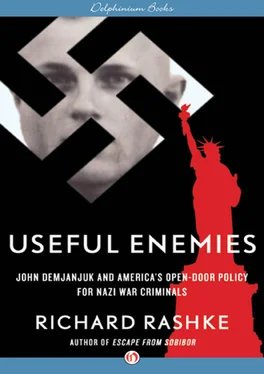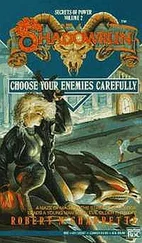What happened next played like a scene from a Washington soap opera.
Without warning, Panama offered Linnas asylum on humanitarian grounds. Washington heaved a heavy sigh of relief and accepted the generous offer. Now all it had to do was dodge the Jewish flak that was sure to explode over the capital. Attorney General Meese agreed to be the fall guy for the White House.
On Passover 1987, Elizabeth Holtzman got a call from Eli Rosenbaum, a former OSI prosecutor who would soon return to that office. Rosenbaum was upset. The Justice Department had secretly made a deal, he told Holtzman, to deport Linnas to Panama instead of to Estonia. Since the Central American country did not have an extradition treaty with the Soviet Union, America was, in effect, providing a safe haven for Linnas. The deal was a political pitch to the hearts and wallets of voters.
Holtzman was steaming.
It was no accident that the Justice Department chose to smuggle Linnas into Panama during Passover, when Jewish offices were closed and most Jews were home observing the holy day with their families. Holtzman was angry at the cynical attempt to use the Jewish holiday as cover to sneak a murderer of Jews out of the country. And she was seething at the thought that a war criminal like Linnas would, in her words, “live out his life peacefully, resting on a beach under a palm tree.”
There was no time to be religious or philosophical on that Passover day. Holtzman huddled with her top aide, Ed O’Malley; Rosenbaum, who would one day head OSI; and Menachem Rosensaft, a lawyer and Jewish leader. The four came up with an end-around play. They would notify the press that Panama was about to grant sanctuary to a Nazi collaborator and that Jewish groups were poised to rise up in protest. O’Malley and Rosenbaum would then separately call the Panamanian embassy to express indignation and to issue a warning about the next-day tidal wave of protest. Jews would march on Washington, they assured the embassy, and demonstrate outside Panamanian offices from the United Nations to Panama City.
The sucker-play worked.
Panamanian embassy officials in Washington agreed to a three o’clock meeting that Passover afternoon. Holtzman and her team rode the shuttle from New York to Washington, where the embarrassed Panamanian ambassador to the United States told them that Panama had withdrawn its offer to accept Karl Linnas. Not since the debate over the fate of the Panama Canal, the ambassador said, had there been so much media attention. Then he startled Holtzman and her group by stating that Panama’s acting president, Eric Arturo Delvalle, was Jewish, a fact not widely known.
That night, an exhausted Eli Rosenbaum sat in an uncomfortable hot seat facing Patrick Buchanan and Robert Novak on CNN’s Crossfire. Buchanan argued that Linnas was not responsible for the deaths of twelve thousand Jews and that to deport him to Estonia would be to lynch him. The number of alleged victims, Buchanan argued, was Soviet-supplied disinformation. At most, Linnas was responsible for the deaths of four or five hundred men, women, and children, Buchanan conceded.
“How many Jewish bodies are enough to meet the quota?” Rosenbaum shot back. Buchanan didn’t respond.
The United States eventually deported Linnas to Estonia. But before the Soviets could make good on their promise to retry him, Linnas died from heart and kidney failure. His deportation and death only served to further enrage Baltic, Ukrainian, and Belorussian émigré communities and convince them that OSI and the Jews were out to get them. Émigré publications warned their readers not to cooperate with OSI investigators. They could be next.
But Moscow was happy. And that made OSI happy.
In January 1983, while Demjanjuk was waiting for his deportation hearing to open, another ticking bomb plopped into the lap of political Washington. His name was Klaus Barbie, the Butcher of Lyon. Like offal rising from a river bottom, new evidence suggested that the United States was hiding another dirty secret. The media were on it like flies on rotting beef. If the new evidence was correct, Barbie was a Jekyll and Hyde story. Jekyll (Uncle Sam) hunting Nazi war criminals for prosecution at Nuremberg by day. Hyde (Uncle Sam) hiring the best of the lot by night.
OSI director Allan Ryan followed the unfolding Barbie story with alarm. He knew that some Barbie dirt was sure to smudge OSI and challenge, if not cripple, its shaky credibility. To protect OSI from allegations of hiding the truth from the American people, Ryan asked the Justice Department for permission to open an immediate in-depth and fully-funded investigation of the U.S. role in l’affaire Barbie. If the Justice Department didn’t pull the story together, Ryan argued, “every network, newspaper and self-styled Nazi hunter would.”
After sitting on the fence for nearly three months, U.S. attorney general William French Smith, Meese’s predecessor, caved in to the mounting media pressure for answers and gave Ryan the nod. Over the next six months, Ryan rummaged through a roomful of government documents and conducted hundreds of interviews. What he found confirmed his worst nightmare.
• • •
Berlin had a problem in Lyon, France, in 1942. Resistance fighters (Maquis, from the French word for underbrush) were blowing up bridges and supply trains, hiding Allied airmen shot down over France and Belgium, and assassinating German officers. Berlin sent SS Captain Klaus Barbie to Lyon to clean up the mess. As Lyon’s new Gestapo chief, Barbie’s job was to capture Resistance leader Jean Moulin, crack the spine of the movement, and ferret out every Jew within reach. Barbie was somewhat successful.
On a tip from a Resistance snitch, Barbie captured Moulin during a clandestine meeting and tortured him. Moulin died without revealing the names of his fellow Maquis. Because he failed to break Moulin, Barbie managed only to cripple the Resistance. With the help of French collaborators, he murdered up to four thousand Frenchmen, sent hundreds more to Camp Dora, and rounded up approximately fourteen thousand Jews, including orphans, for transport to Auschwitz.
Unlike Ustashi Andrija Artukovic and Iron Guardist Viorel Trifa, Barbie was not satisfied watching his men torture suspects inside his Gestapo headquarters in Montluc prison, dubbed Hôtel Terminus. Barbie was a hands-on kind of Nazi who rolled up his sleeves and personally beat men and women with enthusiasm. From time to time, he played God with an acetylene torch. For the most part, however, he left the really nasty torture to his goons.
U.S. intelligence officers loved him.
In 1972, French Nazi hunter Beate Klarsfeld found Barbie hiding in La Paz, Bolivia, under the name Klaus Altmann. West Germany immediately asked Bolivia to extradite him so it could try him for crimes against humanity. But the Supreme Court of Bolivia’s right-wing military dictator and drug czar, General Hugo Banzer, refused the extradition request.
Barbie lived in La Paz for eleven more years under the protection of his boss, General Banzer, until a new Bolivian government was formed in 1983. The new government decided to get rid of Barbie along with the general. It arrested him on minor fraud charges, ordered his expulsion, and put him on a flight to Frankfurt, where he was welcomed with shudders of shock. Not sure what to do with him on such short legal notice, Germany put him on a Lufthansa flight back to La Paz. The Bolivians, in turn, flew him to French Guiana, just north of Brazil, where a French military jet was waiting to fly him to Lyon and a room in Hôtel Terminus.
Not only did Barbie’s arrest make international headlines; it smoked out from retirement a former U.S. Army Counter Intelligence Corps (CIC) officer with a problem of conscience. The officer told NBC’s Today show that he had hired Barbie in 1947 to inform on Soviet activities in Europe. More international headlines. The New York Times , among others, wondered out loud how Klaus Barbie ended up in Bolivia with a new identity. If he had worked for CIC in Germany, could it be that the United States had helped the Butcher of Lyon escape to South America?
Читать дальше












